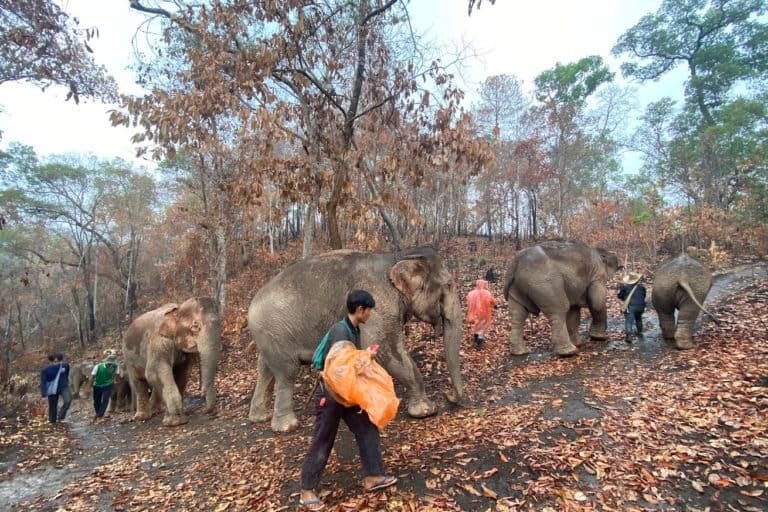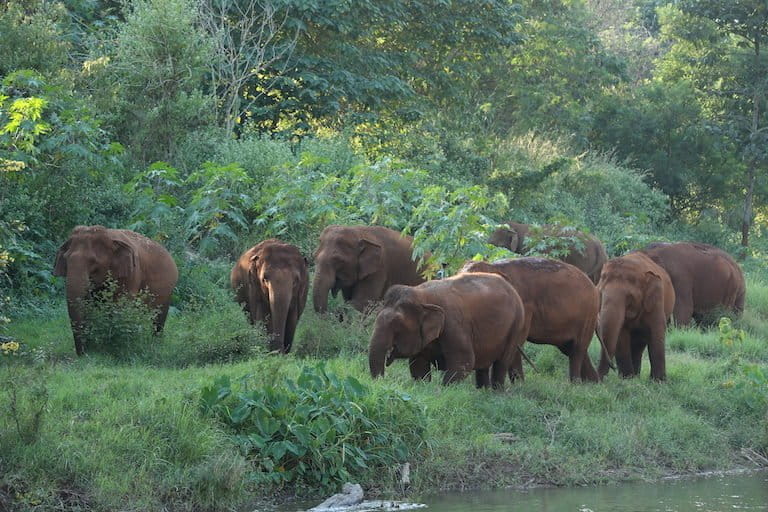- With tourism collapsing due to the COVID-19 pandemic, the 2,700 captive elephants used for tourism purposes in Thailand faced a crisis.
- Many elephants and their keepers trekked back to their owners’ native villages, where it was hoped they could forage naturally. Others remained in camps, often in chains and with fewer staff to care for them.
- The welfare of elephants in villages depends greatly on the amount of intact forest available to them. But experts say welfare monitoring is difficult.
- Campaigners are calling on the Thai government and tourism industry to make systemic changes to improve conditions and reduce the number of elephants used for tourism.
In March 2020, a massive migration began when an international travel ban to curb COVID-19 brought Thailand’s tourism industry to a sudden halt. Elephant camps, which use more than 2,700 captive elephants for controversial trekking, bathing and riding tours, were hit by the double whammy of a lack of tourist revenue and relentless gargantuan food bills. Dozens of camps shut down, and elephants and staff were laid off in their thousands.
Many of those elephants were leased from owners who live in remote rural locations, where the tradition of keeping elephants goes back generations. Faced with an uncertain future and looming food shortages in tourism hubs, hundreds of elephants and their keepers trekked back to their native villages, where cash-strapped owners hoped the elephants could forage naturally in the forest until tourism returned.
“People thought [the COVID-19 crisis] would last a couple months, but now it has been one year,” says Saengduean “Lek” Chailert, founder of Save Elephant Foundation, a nonprofit organization based in Chiang Mai province that rescues and rehabilitates animals from across the country. Like many, she says she was hopeful the elephants’ return home would be the beginning of a significant change in their working lives.

Back in chains
Last year, Lek accompanied a group on the arduous walk home to their Karen villages in northwest Thailand. Their five-day journey of more than 100 kilometers (60 miles) took them across hillsides charred by seasonal fires and through forests where they slept at night. Upon arrival, the elephants and their keepers were warmly welcomed; villagers had prepared fruit for the animals and sang songs in celebration.
The dispersal of so many elephants presents new challenges in elephant welfare monitoring. “It was quite easy to document conditions in camps because they were right there in front of us,” says Jan Schmidt-Burbach of World Animal Protection, an organization that has studied elephant welfare in Thailand for more than a decade. “Now, we struggle to understand the conditions the elephants face. But so far, we have yet to come across evidence of large-scale suffering in their new locations.”
Starvation was the major concern when the pandemic lockdown initially hit the elephant tourism industry. Although cases of malnutrition and deterioration due to poor-quality feed have been documented, widespread starvation has not occurred. This is in part due to communities coming together to ensure the elephants are fed.
Elephant organizations have partnered with farmers to grow a steady supply of food and coordinate distribution. Save Elephant Foundation, which receives daily requests for help, food and medical care, launched a food bank last May, whereby it leases land from farmers whose markets have dwindled during the pandemic. To date, the initiative has supported 260 camps, feeding close to 2,000 elephants across the country.

Speaking to Mongabay by video call in March 2021, Lek enthusiastically showcased piles of sugarcane, pumpkins, corn and watermelons awaiting distribution to more than 560 elephants around Chiang Mai province in honor of Thailand’s National Elephant Day, held annually on March 13.
Notwithstanding their initial excitement and resourcefulness in feeding the returned elephants, many villagers across the region are struggling to find enough space for them in the long term. “Their reality is terrible,” Lek says.
During the decades since elephants were last kept in some of these remote villages, swaths of teak and bamboo forest have been cleared for rice paddies and maize fields. Often there is simply not enough accessible forest to allow elephants to roam free and forage naturally. There is also an elevated risk of conflict between hungry elephants and farmers. In the worst cases, “they are back in chains again,” Lek says. “Their lives are no better than in the camps.”
With more elephants living in proximity to agricultural land, accidents can happen. Save Elephant Foundation recently responded to a request for help from a village where seven elephants, including a mother and baby, had eaten chemical insecticide used to treat crops. According to the elephant hospital at the Thai Elephant Conservation Center in Lampang, where the elephants are now recovering, this incident is part of a rising trend in elephant poisonings by agrochemicals.
Nevertheless, in villages where intact forest is still within reach, elephants have the chance to merge with their natural environment. “Some remote Karen communities in hillside areas towards the Thai-Myanmar border employ practices whereby they have the elephants in the nearby forests and allow them some freedom to graze and forage,” Schmidt-Burbach says.
Save Elephant Foundation is working alongside other nonprofits, including Trunks Up and Gentle Giants, to maximize the chances of elephants roaming free in forests and to help owners to secure space for their elephants to live unchained. To date, they have helped the owners of 218 elephants generate income and care for their elephants close to the forest, so that they will not have to return to the tourist industry once the pandemic subsides.
Still, elephant ownership is a burden many cannot bear. In recent months, more than 50 elephants have been offered up for sale by struggling owners around the country. Moreover, Save Elephant Foundation has provided refuge for 23 additional elephants at its Elephant Nature Park sanctuary since the pandemic began.

Unethical practices resurfacing
While circumstances vary for elephants that returned to villages, experts agree conditions have likely deteriorated for those remaining in camps. With tourists gone and staffing down, many elephants have spent the last year chained, with little opportunity for exercise. “These elephants get bored and, due to a lack of movement, they develop more health problems,” Chatchote Thitaram, a veterinary specialist at Chiang Mai University’s Center of Excellence in Elephant Research and Education, told Mongabay.
With the loss of international tourists, some elephant camps are capitalizing on a rise in domestic tourism. World Animal Protection has received reports of some unethical practices resurfacing that had become less common before the pandemic. “In Phuket, young elephants are reportedly being led into the ocean to pose for photographs with tourists,” Schmidt-Burbach says.
The pandemic has highlighted the risks to elephants and their keepers of overdependence on tourism, prompting animal welfare organizations to call on the government and the tourism industry for policy changes.
But with revenue from Thailand’s captive elephant entertainment industry estimated at more than $500 million per year, effecting change is an uphill struggle. Legislation still classifies captive elephants as commodities. “The business side of the elephant tourism industry fights hard to protect its interests,” Lek says. “But we continue to go and show why elephants need and deserve laws to protect them.”
World Animal Protection is working with the tourism industry to implement better practices, so that reliance on tourism and the number of captive elephants decrease. It is currently supporting 12 camps, which house a total of 75 elephants and employ 170 staff, based around observation-only tourism.
“An interesting development we’ve seen in the last few years, right up to the start of the pandemic, is more travel companies — not only in Western countries but also in China — dropping conventional elephant activities, such as elephant riding, in favor of observation-only and more-humane alternatives,” Schmidt-Burbach says. “I really hope that the travel industry will pick up where they left off at the start of the pandemic and not fall back into greed-driven profit-maximization.”

Breeding to recoup lost profits
Despite this shift in tourist attitudes toward more humane practices, the sheer volume of pre-pandemic tourists more than sustained demand. Over the last decade, the overall number of captive elephants used for tourism in Thailand increased by 70%, according to a 2020 report by World Animal Protection that studied elephant welfare in several Asian countries. And further increases could be on the horizon.
The organization is now concerned that owners will use the downtime to breed their elephants in captivity, banking on profits from an anticipated post-pandemic tourism surge.
In June 2020, World Animal Protection and 190 other organizations asked the Thai government to issue a temporary ban on private elephant breeding to prevent a swell in captive elephant numbers. To date, the Thai government has issued no response.
Such captive breeding is happening, sometimes with unexpected consequences. A distressed elephant owner recently contacted Lek: He had released his captive herd to breed with wild bulls that frequented nearby forests, hoping that the offspring would benefit from the strong genes of the wild population. However, rather than returning to the village, the captive herd joined the wild elephants and walked off into the forest.
They are yet to return.
Banner image: Elephants and their keepers trekking back to their owners’ home villages in May 2020, courtesy of Save Elephant Foundation.
FEEDBACK: Use this form to send a message to the author of this post. If you want to post a public comment, you can do that at the bottom of the page.
"captivity" - Google News
April 01, 2021 at 07:19PM
https://ift.tt/3sI2zcg
Mixed fates for captive elephants sent back to villages amid Thai tourism collapse - Mongabay.com
"captivity" - Google News
https://ift.tt/3b01anN
https://ift.tt/3dbExxU
Bagikan Berita Ini















0 Response to "Mixed fates for captive elephants sent back to villages amid Thai tourism collapse - Mongabay.com"
Post a Comment